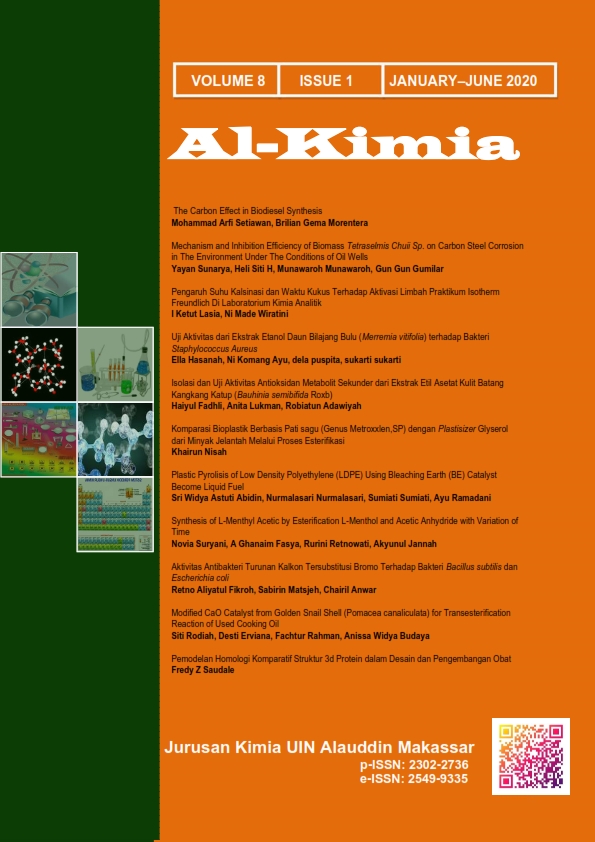Pengaruh Suhu Kalsinasi dan Waktu Kukus Terhadap Aktivasi Limbah Praktikum Isotherm Freundlich Di Laboratorium Kimia Analitik
Abstrak
This study aims to determine the effect of calcination temperature and steaming time on the activation of freundlich isotherm practicum waste (LPIF) in the Analytical Chemistry Laboratory. The LPIF was taken from the waste of the Physical Chemistry Practicum at the Analytical Chemistry Laboratory, Department of Chemistry, Ganesha University of Education. To achieve the research objectives, the LPIF was calcined at 165oC and 195oC, then steamed with 900 mL of distilled water at 400oC for 60 minutes and 45 minutes, respectively. The results of LPIF activation were characterized by absorption, increasing of absorption, FTIR spectrum, and SEM morphology. The results of the study showed that there were influences of calcination temperature and steaming time on LPIF in the Analytical Chemistry Laboratory. The best temperature of calcination and steaming time for activation of LPIF was calcination temperature of 195oC and steaming for 45 minutes.
##plugins.generic.usageStats.downloads##
Referensi
Andreas O. Wagner, Nadine Praeg, Christoph Reitschuler & Paul Illmer (2015), Effect of DNA extraction procedure, repeated extraction and ethidium monoazide (EMA)/propidium monoazide (PMA) treatment on overall DNA yield and impact on microbial fingerprints for bacteria, fungi and archaea in a reference soil, Appl Soil Ecol, 93, 56–64.
Byeong Ho Min, Kyeong Youl Jung (2017), Improved porosity and ionic sorption capacity of carbon particles prepared by spray pyrolysis from an aqueous sucrose/NaHCO3/ TEOS solution, RSC Adv, 7, 21314–21322.
Hudha, A. M. (2002), Penyelenggaraan praktikum pada mahasiswa Jurusan Pendidikan Biologi FKIP UMM, Laporan Penelitian, Malang: Lemlit UMM.
Hyung Won Lee, Young-Min Kim, Seungdo Kim, Changkook Ryu, Sung Hoon Park & Young Kwon Park (2018), Review of the use of activated biochar for energy and environmental applications, Carbon Letters, 26, 1-10.
Lagunova Yu. O., Seliverstov F., Ershov G. & Basiev (2012), Oxidative decomposition of oxalate ions in water solutions of concentrated g ozone, Atomic Energy, 113(2), 93–95.
Lasia I Ketut, Budiada I Ketut (2017), Efisiensi pengolahan karbon limbah praktikum di laboratorium kimia analitik, Proseding Seminar Nasional Riset Inovatif, 67-72.
Mursid, R. (2013) Pengembangan model pembelajaran praktik berbasis kompetensi berorientasi produksi, Cakrawala Pendidikan, XXXII (1), 27-40.
Peraturan Bersama Menpan dan Kepala BKN No. 02/V/PB.2010. No.13 th. 2013 tentang Petunjuk Pelaksanaan Jabatan Fungsional PLP dan Angka Kreditnya.
Ponkarthikeyan P., Sutha Sree K.(2017), A review of activated carbon by chemical activation, ICRTCETM, Special issue, 524-531.
Sani (2011), Pembuatan karbon aktif dari tanah gambut, Jurnal Teknik Kimia, 5(2), 400-4006.
Taza Gul, Shakeela Afridi, Farhad Ali, Ilyas Khan & Ali Saleh Alshomrani (2018), Heat transmission in the liquid film flow of micropolar fluid in a poros medium over a stretching sheet with thermal radiation, Journal of Nanofluids, 7, 1–9.
Werner Mäntele, Erhan Deniz (2017), UV–vis absorption spectroscopy: lambert-beer reloaded. spectrochimica Acta Part A: Molecular and Biomolecular Spectroscopy, 173(15), 965-968
William Blum (2017), The hydrolysis of sodium oxalate and its influence upon the test for neutrality (Classic Reprint), Forgotten Books, 521.
Wiratini Ni Made, Retug Nyoman (2014), Penuntun Praktikum Kimia Fisika, Singaraja: Jurusan Pendidikan Kimia FMIPA Universitas Pendidikan Ganesha.
Yakout S.M., Sharaf El Deen G. (2016), Characterization of activated carbon prepared by phosphoric acid activation of olive stones, Arabian Journal of Chemistry, 9, S1155–S1162.
You J. H., Chiang H. L. & Chiang P. C. (1994), Comparison of adsorption characteristics for VOCs on activated carbon and oxidized activated carbon, Environmental Progress, 13(1), 31-36.
##submission.copyrightStatement##
##submission.license.cc.by-nc-sa4.footer##Authors who publish with this journal agree to the following terms:
1) Authors retain copyright and grant the journal right of first publication with the work simultaneously licensed under a Creative Commons Attribution License that allows others to share the work with an acknowledgement of the work's authorship and initial publication in this journal.
2) Authors are able to enter into separate, additional contractual arrangements for the non-exclusive distribution of the journal's published version of the work (e.g., post it to an institutional repository or publish it in a book), with an acknowledgement of its initial publication in this journal.
3)Authors are permitted and encouraged to post their work online (e.g., in institutional repositories or on their website) prior to and during the submission process, as it can lead to productive exchanges, as well as earlier and greater citation of published work (See The Effect of Open Access).


